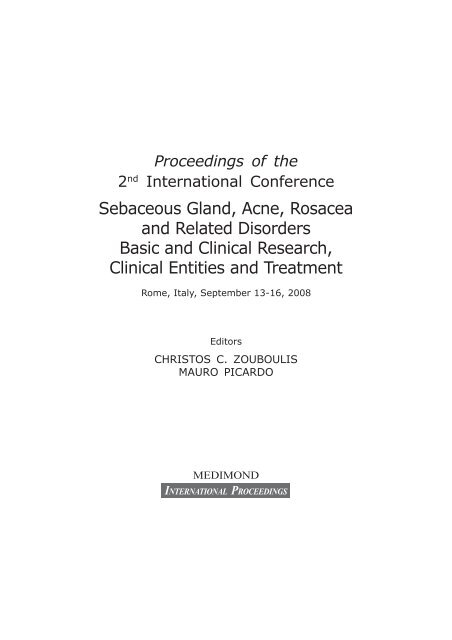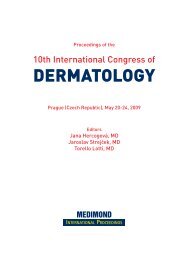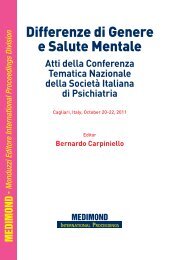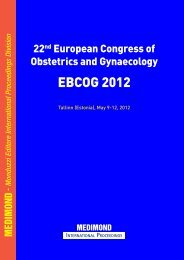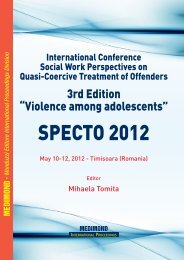Sebaceous Gland, Acne, Rosacea and Related Disorders Basic and ...
Sebaceous Gland, Acne, Rosacea and Related Disorders Basic and ...
Sebaceous Gland, Acne, Rosacea and Related Disorders Basic and ...
You also want an ePaper? Increase the reach of your titles
YUMPU automatically turns print PDFs into web optimized ePapers that Google loves.
2nd Proceedings of the<br />
International Conference<br />
<strong>Sebaceous</strong> <strong>Gl<strong>and</strong></strong>, <strong>Acne</strong>, <strong>Rosacea</strong><br />
<strong>and</strong> <strong>Related</strong> <strong>Disorders</strong><br />
<strong>Basic</strong> <strong>and</strong> Clinical Research,<br />
Clinical Entities <strong>and</strong> Treatment<br />
Rome, Italy, September 13-16, 2008<br />
Editors<br />
CHRISTOS C. ZOUBOULIS<br />
MAURO PICARDO<br />
MEDIMOND<br />
INTERNATIONAL PROCEEDINGS
© Copyright 2008<br />
MEDIMOND S.r.l. Via Maserati 5, 40128 Bologna, Italy<br />
MONDUZZI EDITORE<br />
INTERNATIONAL PROCEEDINGS DIVISION<br />
Tel. +39 0514151123 Fax +39 051 370529<br />
www.medimond.com info@medimond.com<br />
All rights reserved. No part of this publication may be reproduced,<br />
stored in a retrieval system, or transmitted, in any form,<br />
or by any means, electronic, mechanical, photocopying,<br />
recording or otherwise, without the prior permission,<br />
in writing, from the publisher.<br />
Graphic layout by Gamma Graphic • Bologna (Italy)<br />
Printed in May 2009 by Editografica Rastignano Bologna (Italy)
FOREWORD<br />
Seorrhoea, acne <strong>and</strong> rosacea are very common clinical disorders.<br />
Together they comprise the group of skin disorders which requires more<br />
treatment by dermatologists <strong>and</strong> other physicians than any other. Due<br />
to this it is not surprising that the global interest in the physiology <strong>and</strong><br />
pathology of the sebaceous gl<strong>and</strong>, the major skin organ involved, is<br />
rapidly increasing. Current knowledge about the sebaceous gl<strong>and</strong> suggests<br />
that it is not merely the target of acne, but through its multiple<br />
functions, represents “the brain of the skin”. Newly developed in vitro<br />
models have facilitated this fascinating research; resulting in increasing<br />
numbers of scientists <strong>and</strong> clinicians from different specialties getting<br />
involved in sebaceous gl<strong>and</strong> research. Including studies on: physiology,<br />
pathology <strong>and</strong> pharmacology, of the sebaceous gl<strong>and</strong> <strong>and</strong> the<br />
pilosebaceous unit. Rapid developments in basic research <strong>and</strong> medicine<br />
elsewhere have also influenced our field, this has resulted in numerous<br />
reports appearing in many scientific journals <strong>and</strong> being announced<br />
in specialty conferences all over the world.<br />
This extensive expansion of knowledge makes it very difficult for<br />
scientists to keep up-to-date with the latest progress in this research.<br />
Considering that over a decade had past since the Workshop on the<br />
<strong>Sebaceous</strong> <strong>Gl<strong>and</strong></strong> (Brussels 1995) <strong>and</strong> the 1st International Conference<br />
on <strong>Sebaceous</strong> <strong>Gl<strong>and</strong></strong>, <strong>Acne</strong>, <strong>Rosacea</strong> <strong>and</strong> <strong>Related</strong> <strong>Disorders</strong>, (Berlin,<br />
1997) another Conference was over due; in order to discuss the<br />
numerous developments in this exp<strong>and</strong>ing field. Therefore it was a great<br />
honour to arrange <strong>and</strong> invite interested parties to attend the 2nd International<br />
Conference on <strong>Sebaceous</strong> <strong>Gl<strong>and</strong></strong>, <strong>Acne</strong>, <strong>Rosacea</strong> <strong>and</strong> <strong>Related</strong><br />
<strong>Disorders</strong>- “<strong>Basic</strong> <strong>and</strong> Clinical Research, Clinical Entities <strong>and</strong> Treatment”<br />
which was held between the 13-16 September 2008 in Rome,<br />
Italy at the IFO Congress Center “Raffaele Bastianelli”.
VI Foreword<br />
The purpose of the conference was to construct a high impact scientific<br />
programme, which provided information on the current research,<br />
with clinical relevance to the disorders of the pilosebaceous unit. The<br />
speakers were chosen for their contribution <strong>and</strong> impact on the discussed<br />
areas. With the intention of not only attracting expects but also to motivate<br />
young scientists <strong>and</strong> students, working, or wishing to work in<br />
this fascinating area of study in the future.<br />
The Conference was a great success <strong>and</strong> we felt very honoured to<br />
host so many speakers with such major expertise during the event. The<br />
selection of expertise was extensive <strong>and</strong> demonstrated again how this<br />
fascinating area of research continues to attract great interest from<br />
both established scientists <strong>and</strong> new ones to the field.<br />
Now we present the proceedings of this meeting; where most of the<br />
invited lectures <strong>and</strong> selected oral presentation are incuded. The index<br />
follows the program of the meeting.<br />
We hope that this proceeding, which clearly <strong>and</strong> shortly summarises<br />
the main concepts of the presentation can be helpful to clinical dermatologists<br />
providing a synthetic up date on the sebaceous gl<strong>and</strong>, acne,<br />
rosacea <strong>and</strong> related disorders.
INDEX<br />
THE PILOSEBACEOUS UNIT: STRUCTURE, FUNCTION AND<br />
CONTROL<br />
Epidermal Surface Lipids<br />
A. Pappas ..................................................................................................................... 1<br />
<strong>Sebaceous</strong> <strong>Gl<strong>and</strong></strong> Lipids<br />
M. Picardo ................................................................................................................... 5<br />
<strong>Sebaceous</strong> <strong>Gl<strong>and</strong></strong> Receptors<br />
C.C. Zouboulis ............................................................................................................ 9<br />
Neuropeptides <strong>and</strong> <strong>Acne</strong><br />
R. Ganceviciene, M. Böhm, Graziene,<br />
S. Fimme <strong>and</strong> C.C. Zouboulis .................................................................................... 17<br />
Role of FGFR2-Signaling in the Pathogenesis of <strong>Acne</strong><br />
B. Melnik ..................................................................................................................... 23<br />
Sebum Analysis of Individuals with <strong>and</strong> without <strong>Acne</strong><br />
A. Pappas, S. Johnsen, J.-C. Liu <strong>and</strong> M. Eisinger ................................................... 27<br />
The Use of ZincamideÒ as Coadjuvant to Treatment with Adapalene in<br />
Mild or Moderate <strong>Acne</strong> Reduces Erythema <strong>and</strong> Seborrhoea <strong>and</strong> Improves<br />
Quality of Life<br />
M. Pérez, M. Saban,<br />
R. Pedragosa, M.J. Espadas,<br />
A. Mirada <strong>and</strong> C. Trullás ........................................................................................... 31<br />
Phospholipases Stimulate Lipogenesis in SZ95 Sebocytes<br />
S. Schagen, A. Perchuc, R. Voegeli,<br />
D. Imfeld, T. Schreier <strong>and</strong> C. Zouboulis ................................................................... 35<br />
ENDOCRINOLOGY: FROM GENE TO THE PATIENT<br />
Hormones <strong>and</strong> the Pilosebaceous Unit<br />
W. Chen <strong>and</strong> C. Zouboulis ......................................................................................... 39
VIII Index<br />
MICROBIOLOGY, IMMUNOLOGY AND INFLAMMATION<br />
The <strong>Acne</strong> Biofilm<br />
K. Honraet, B. Rossel, T. Coenye <strong>and</strong> H. Nelis ........................................................ 47<br />
Propionibacterium <strong>Acne</strong>s Coordinately Augments Lipogenesis <strong>and</strong><br />
Matrix Metalloproteinase 2 Expression in Hamster Sebocytes<br />
T. Sato, K. Iinuma, N. Akimoto, N. Noguchi,<br />
M. Sasatsu <strong>and</strong> A. Ito ................................................................................................. 49<br />
TNFα Gene Polymorphisms in the Pathogenesis of <strong>Acne</strong> Vulgaris<br />
K. Szabó, G. Tax, D. Teodorescu-Brinzeu,<br />
A. Koreck <strong>and</strong> L. Kemény ......................................................................................... 53<br />
NUTRITION AND ENVIRONMENT<br />
Nutrition in <strong>Acne</strong><br />
F. Danby ....................................................................................................................... 57<br />
Tissue <strong>and</strong> Serum Inflammatory Cytokines Associated to <strong>Acne</strong><br />
in Relation to Cigarette Smoke<br />
V. Bordignon, J.L. Sinagra, A. Vento, S. Bultrini,<br />
P. Cordiali-Fei, B. Capitanio <strong>and</strong> F. Ensoli .............................................................. 67<br />
ROSACEA: RESEARCH AND CLINICAL ASPECTS<br />
Rhinophyma – Current Status<br />
U. Wollina .................................................................................................................... 71<br />
Possible Interaction Between Neuropeptides <strong>and</strong> UV Light in the Development<br />
of <strong>Rosacea</strong><br />
S. Fimmel, E. Glass <strong>and</strong> C.C. Zouboulis ................................................................... 75<br />
ACNEIFORM DERMATOSES: CLINICAL ASPECTS AND<br />
TREATMENTS<br />
The SAPHO Syndrome<br />
I. Olivieri, V. Giasi, S. D’Angelo,<br />
C. Palazzi <strong>and</strong> A. Padula ............................................................................................ 81<br />
ACNE: CLINICAL ASPECTS AND TREATMENTS<br />
<strong>Acne</strong>: Clinical Aspects<br />
M. Herane.................................................................................................................... 85
Index<br />
Modern Technology <strong>and</strong> Imaging for the Detection <strong>and</strong> Evaluation of<br />
<strong>Acne</strong><br />
N. Kollias <strong>and</strong> G.O. Cula ............................................................................................ 91<br />
Prepubertal <strong>Acne</strong><br />
A.W. Lucky .................................................................................................................. 99<br />
Myths <strong>and</strong> Beliefs of <strong>Acne</strong> Pathogenesis<br />
R. Wolf ......................................................................................................................... 105<br />
Establishment of <strong>Acne</strong> Severity Grading in Japan<br />
N. Hayashi, H. Akamatsu, M. Kawashima<br />
<strong>and</strong> Japanese acne study group ................................................................................. 113<br />
Zileuton, a New Efficient <strong>and</strong> Safe Systemic Anti-acne Drug<br />
C.C. Zouboulis ............................................................................................................ 119<br />
Advances in Measures of Clinical <strong>Acne</strong> Severity<br />
J. Tan ............................................................................................................................ 129<br />
PATIENT MANAGEMENT: PSYCHOLOGICAL ASPECTS AND<br />
QUALITY OF LIFE<br />
Measurement of Quality of Life<br />
A.Y. Finlay ................................................................................................................... 135<br />
PATIENT MANAGEMENT: PHYSICAL TREATMENTS<br />
Variability in Absorption of Minocycline Clinical Implications<br />
M. Wortzman <strong>and</strong> J. Leyden ..................................................................................... 143<br />
Chemical Peeling for <strong>Acne</strong> in Japan<br />
Y. Miyachi.................................................................................................................... 149<br />
Azelaic Acid Counteracts the Inflammatory Response Elicited in Human<br />
Keratinocytes<br />
E. Camera, A. Mastrofrancesco, E. Izzo, N. Aspite,<br />
M. Ottaviani <strong>and</strong> M. Picardo .................................................................................... 153<br />
Auhtor Index ................................................................................................................ 159<br />
IX


